matlab概率统计
matlab在概率统计中的计算
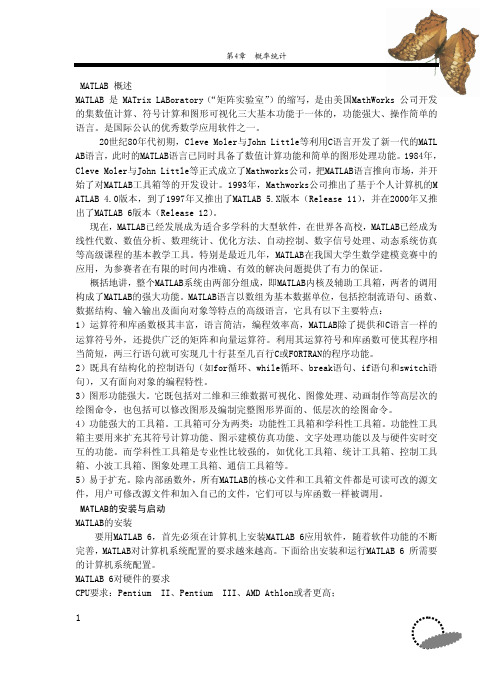
4.1 计算组合数、验证概率的频率定义,计算古典概率
4.1.1 计算nk.
P
P
使用语句n^k
4
第4章 概率统计
例如计算 511
N=5^11 N=
48828125
如计算 5−2.8
N=5^(-2.8) N=
0.0110
4.1.2 计算组合数 Cnk
计算组合数 Cnk 时,使用语句nchoosek(n,k).
1
MATLAB6.0数学手册
光驱:8倍速以上; 内存:至少64MB,但推荐128MB以上; 硬盘:视安装方式不同要求不统一,但至少留1GB用于安装(安装后未必有1GB); 显卡:8位; MATLAB 6对软件的要求 Windows95 、Window98、Windows NT或Windows2000; Word97或word2000等,用于使用MATLAB Notebook; Adobe Acrobat Reader 用于阅读MATLAB的PDF的帮助信息。 MATLAB 6的安装和其它应用软件类似,可按照安装向导进行安装,这里不再赘述。 MATLAB的启动和退出 与常规的应用软件相同,MATLAB的启动也有多种方式,首先常用的方法就是双击桌面的 MATLAB图标,也可以在开始菜单的程序选项中选择MATLAB组件中的快捷方式,当然也可 以在MATLAB的安装路径的子目录中选择可执行文件“MATLAB.exe”。 启动MATLAB后,将打开一个MATLAB的欢迎界面,随后打开MATLAB的桌面系统(Desktop) 如图2-1所示。
在MATLAB命令行操作中,有一些键盘按键可以提供特殊而方便的编辑操作。比如:“↑” 可用于调出前一个命令行,“↓”可调出后一个命令行,避免了重新输入的麻烦。当然下 面即将讲到的历史窗口也具有此功能。 历史窗口(Command History) 历史命令窗口是MATLAB6新增添的一个用户界面窗口,默认设置下历史命令窗口会保留自 安装时起所有命令的历史记录,并标明使用时间,以方便使用者的查询。而且双击某一 行命令,即在命令窗口中执行该命令。 当前目录窗口(Current Directory )
MATLAB应用基础(概率统计)

第4章概率统计本章介绍MATLAB在概率统计中的若干命令和使用格式,这些命令存放于MatlabR12\Toolbox\Stats中。
4.1 随机数的产生4.1.1 二项分布的随机数据的产生命令参数为N,P的二项随机数据函数binornd格式R = binornd(N,P) %N、P为二项分布的两个参数,返回服从参数为N、P的二项分布的随机数,N、P大小相同。
R = binornd(N,P,m) %m指定随机数的个数,与R同维数。
R = binornd(N,P,m,n) %m,n分别表示R的行数和列数例4-1>> R=binornd(10,0.5)R =3>> R=binornd(10,0.5,1,6)R =8 1 3 7 6 4>> R=binornd(10,0.5,[1,10])R =6 8 4 67 5 3 5 6 2>> R=binornd(10,0.5,[2,3])R =7 5 86 5 6>>n = 10:10:60;>>r1 = binornd(n,1./n)r1 =2 1 0 1 1 2>>r2 = binornd(n,1./n,[1 6])r2 =0 1 2 1 3 14.1.2 正态分布的随机数据的产生命令参数为μ、σ的正态分布的随机数据函数normrnd格式R = normrnd(MU,SIGMA) %返回均值为MU,标准差为SIGMA的正态分布的随机数据,R可以是向量或矩阵。
R = normrnd(MU,SIGMA,m) %m指定随机数的个数,与R同维数。
R = normrnd(MU,SIGMA,m,n) %m,n分别表示R的行数和列数例4-2>>n1 = normrnd(1:6,1./(1:6))n1 =2.1650 2.31343.02504.0879 4.8607 6.2827>>n2 = normrnd(0,1,[1 5])n2 =0.0591 1.7971 0.2641 0.8717 -1.4462>>n3 = normrnd([1 2 3;4 5 6],0.1,2,3) %mu为均值矩阵n3 =0.9299 1.9361 2.96404.12465.0577 5.9864>> R=normrnd(10,0.5,[2,3]) %mu为10,sigma为0.5的2行3列个正态随机数R =9.7837 10.0627 9.42689.1672 10.1438 10.59554.1.3 常见分布的随机数产生常见分布的随机数的使用格式与上面相同表4-1 随机数产生函数表4.1.4 通用函数求各分布的随机数据命令求指定分布的随机数函数random格式y = random('name',A1,A2,A3,m,n) %name的取值见表4-2;A1,A2,A3为分布的参数;m,n指定随机数的行和列例4-3 产生12(3行4列)个均值为2,标准差为0.3的正态分布随机数>> y=random('norm',2,0.3,3,4)y =2.3567 2.0524 1.8235 2.03421.9887 1.94402.6550 2.32002.0982 2.2177 1.9591 2.01784.2 随机变量的概率密度计算4.2.1 通用函数计算概率密度函数值命令通用函数计算概率密度函数值函数pdf格式Y=pdf(name,K,A)Y=pdf(name,K,A,B)Y=pdf(name,K,A,B,C)说明返回在X=K处、参数为A、B、C的概率密度值,对于不同的分布,参数个数是不同;name为分布函数名,其取值如表4-2。
概率和统计的MATLAB指令

概率和统计的MATLAB指令1、描述性统计分析描述性统计分析函数标准用法都是对列状数据进行操作。
mean(X):当X为向量,返回向量的均值;当X为矩阵,返回矩阵的每列元素均值构成的行向量。
min,max,sort,mean,median,std,var,sum,prod,cumsum,sumprod等函数用法与mean类似。
cov(X,Y):这里X,Y为向量,分别代表一个样本,求得样本的协方差。
cov(X):这里X为矩阵,将各列看成一个样本,求得样本协方差矩阵。
corrcoef用法与cov类似,求得相关系数。
[Y,I]=sort(X):当X为向量,Y返回X的升序排列,I返回Y各元素原来的编址,即Y=X(I);当X为矩阵,分别对各列排序。
Y=prctile(X,p):当X为向量,Y返回X的p%上分位数;当X为矩阵,分别求各列的上分位数。
trimmean(X,p):剔除上下各(p/2)%数据以后的均值。
例如:>> data=[11 57 291; 13 54 278;10 66 253; 9 46 307; 16 75 244;15 70 256; 8 40 310] data =11 57 29113 54 27810 66 2539 46 30716 75 24415 70 2568 40 310>> % 注意mean和median的区别>> mean(data),median(data)ans =11.7143 58.2857 277.0000 ans =11 57 278>> % 注意var是std的平方>> std(data),sqrt(var(data)) ans =3.0394 12.7895 26.7457 ans =3.0394 12.7895 26.7457 >> % 注意sum与cumsum不同>> sum(data),cumsum(data) ans =82 408 1939 ans =11 57 29124 111 56934 177 82243 223 112959 298 137374 368 162982 408 1939 >> % 将三列看成三个随机变量>> corrcoef(data)ans =1.0000 0.8299 -0.78320.8299 1.0000 -0.9633-0.7832 -0.9633 1.0000>> % 排序>> [Y,I]=sort(data)Y =8 40 2449 46 25310 54 25611 57 27813 66 29115 70 30716 75 310I =7 7 54 4 33 2 61 1 22 3 16 6 45 5 7>> % prctilr(data,50)等于median(data) >> prctile(data,[25,50,100])ans =9.2500 48.0000 253.750011.0000 57.0000 278.000016.0000 75.0000 310.0000>> % 注意与mean的区别>> trimmean(data,20)ans =11.6000 58.6000 277.00002、统计图bar(Y):作向量Y的条形图。
14MATLAB在概率统计中的应用

(2) (X,Y)落在x+y=1,x=0,y=0所围成的区域内的概率。
程序:
>> syms x y
>> f=exp(-x-y);
>> P_XY=int(int(f,y,0,1),x,0,1)
>> P_G=int(int(f,y,0,1-x),x,0,1)
运行结果显示如下:
P_XY= exp(-2)-2*exp(-1)+1
0.1 0.08 0.06 0.04 0.02
0 0
5
10
15
20
25
30
图 2-1
4.指数分布 例4-10 >>x = 0:0.1:10; >>y = exppdf(x,2); >>plot(x,y)
0.正态分布 例4-16 >> x=-3:0.2:3; >> y=normpdf(x,0,1); >> plot(x,y)
k 1
k 1
的和为随机变量X的数学期望,记为E(X),即
E(X) xkpk (1) k1
说明: (1)E的 X 求 E (X 法 ) x : kpk k1
(2)数学期望 存在性的判断:
看 级 数 xk pk是 否 绝 对 收 敛 。 k 1 即 xk pk是 否 收 敛 ? k1
例1:某厂产品的次品率为0.2 ,每生产一件
解:设h为车门高度,X为身高,求满足条件 P{X>h}0.01的h,即P{X<h}0.99。
程序:
>> h=norminv(0.99,175,6)
结果:
h= 188.9581
matlab概率统计
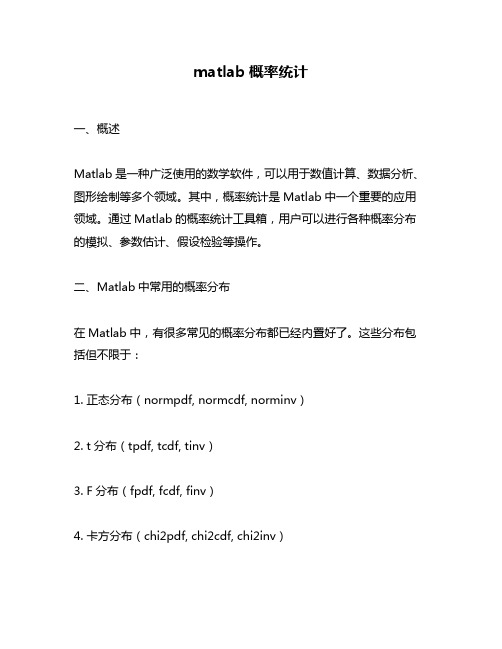
matlab概率统计一、概述Matlab是一种广泛使用的数学软件,可以用于数值计算、数据分析、图形绘制等多个领域。
其中,概率统计是Matlab中一个重要的应用领域。
通过Matlab的概率统计工具箱,用户可以进行各种概率分布的模拟、参数估计、假设检验等操作。
二、Matlab中常用的概率分布在Matlab中,有很多常见的概率分布都已经内置好了。
这些分布包括但不限于:1. 正态分布(normpdf, normcdf, norminv)2. t分布(tpdf, tcdf, tinv)3. F分布(fpdf, fcdf, finv)4. 卡方分布(chi2pdf, chi2cdf, chi2inv)5. 伽马分布(gampdf, gamcdf, gaminv)6. 贝塔分布(betapdf, betacdf, betainv)7. 均匀分布(unifpdf, unifcdf, unifinv)8. 指数分布(exppdf, expcdf, expinv)9. 泊松分布(poisspdf, poisscdf, poissinv)10. 二项式分布(binopdf, binocdf, binoinv)11. 超几何分布(hygepdf, hygecdf, hygeinv)12. 对数正态分布(lognpdf, logncdf, logninv)13. 韦伯分布(wblpdf, wblcdf, wblinv)14. 威布尔分布(weibpdf, weibcdf, weibinv)三、概率分布的模拟在Matlab中,可以使用rand函数来生成服从均匀分布的随机数。
如果需要生成服从其他概率分布的随机数,可以使用相应的概率分布函数。
例如,要生成100个服从正态分布的随机数,可以使用以下代码:```matlabmu = 0; % 正态分布的均值sigma = 1; % 正态分布的标准差x = mu + sigma .* randn(100, 1); % 生成100个服从正态分布的随机数```四、参数估计在实际应用中,我们常常需要根据样本数据来估计未知参数。
如何在Matlab中进行概率统计分析

如何在Matlab中进行概率统计分析在科学研究和数据分析领域,概率统计分析是一项重要的工具。
Matlab作为一种功能强大的数值计算和数据分析的软件平台,在概率统计分析方面有着广泛的应用。
本文将探讨如何在Matlab中进行概率统计分析,并介绍一些常用的技巧和方法。
一、数据导入和预处理在进行概率统计分析之前,首先需要将数据导入Matlab中,并对数据进行预处理。
Matlab提供了各种函数和工具箱,可以简化数据导入和预处理的过程。
例如,使用`xlsread`函数可以将Excel中的数据导入Matlab,使用`csvread`函数可以导入CSV格式的数据。
在数据预处理阶段,常见的操作包括数据清洗、去除异常值、填充缺失值等。
Matlab中的统计工具箱提供了一系列函数,如`fillmissing`、`rmoutliers`等,可以方便地进行数据预处理。
二、描述性统计分析描述性统计分析是对数据的基本特征进行总结和描述,如均值、方差、百分位数等。
Matlab提供了一系列函数,如`mean`、`std`、`prctile`等,可以方便地进行描述性统计分析。
下面以一个示例来说明如何使用Matlab进行描述性统计分析。
假设我们有一组身高数据,可以使用`mean`和`std`函数计算平均身高和身高的标准差:```matlabheight = [165, 170, 175, 180, 185];mean_height = mean(height);std_height = std(height);```三、概率分布拟合概率分布拟合是将观察到的数据拟合到一个概率分布模型中,以了解数据的分布特征。
Matlab中的统计工具箱提供了丰富的函数,可以进行概率分布的拟合和参数估计。
常见的概率分布包括正态分布、指数分布、泊松分布等。
下面以正态分布为例,演示如何在Matlab中进行概率分布拟合:```matlabdata = randn(1000, 1); % 生成1000个服从正态分布的随机数pd = fitdist(data, 'Normal'); % 拟合正态分布mu = pd.mu; % 估计的均值sigma = pd.sigma; % 估计的标准差```四、假设检验假设检验是概率统计分析的重要内容,用于验证关于总体参数的假设。
matlab在概率统计中的应用

matlab在概率统计中的应用
MATLAB在概率统计领域的应用广泛,由于它能精准地模拟出连续变化的数据,因此互联网公司和研究人员也在利用它进行统计分析。
MATLAB是一种在概率统计领域非常有效的分析工具,它可以帮助研究人员和
公司更准确、更快速地了解随机变量的分布、变化趋势等,为研究和决策提供依据。
MATLAB具有方便快捷的数据分析功能,可以进行概率统计领域的数值模拟和
数据挖掘,可以快速生成分析报告、表格摘要和图形展示等。
通过MATLAB,企业
可以迅速获取有效的市场数据,进行统计比较,对在市场上的表现、产品卖点进行准确的定位,提供准确的决策依据。
在投资策略的制定也可以采用这种方式,精准评估投资风险和收益,在避免各种不可靠未知因素造成投资损失的同时,做出更全面、明智的投资决定。
此外,MATLAB还能模拟出各种复杂的随机事件,可以精准预测和模拟不同的
概率统计模型,鉴于互联网公司每天面临的许多难以预测的情况,MATLAB的应用
可以帮助公司提前进行风险应对,更好地把握未来发展趋势。
总之,MATLAB在概率统计领域具有广泛的应用,可以帮助企业更充分地利用
数据,进行更准确、更可靠的数据分析和决策,提高营销策略及投资质量。
Matlab中的概率统计分析

Matlab中的概率统计分析概率统计分析是一门重要的统计学分支,可应用于各行各业。
在数据科学领域中,通过概率统计分析,我们可以对数据集进行探索性分析、建模以及预测。
Matlab作为一种流行的科学计算软件,提供了丰富的工具和函数来进行概率统计分析。
本文将介绍一些常见的概率统计分析方法以及它们在Matlab中的应用。
一、描述统计分析描述统计分析是通过对数据进行总结和可视化,来了解数据的分布和特征。
Matlab提供了多种函数和工具来进行描述统计分析。
例如,我们可以使用`mean`函数来计算数据的均值,使用`std`函数计算标准差。
此外,还可以通过`histogram`函数绘制直方图、通过`boxplot`函数绘制箱线图等。
二、概率分布及参数估计在概率统计分析中,概率分布是描述随机变量的函数。
在Matlab中,我们可以使用各种内置的概率分布函数,如正态分布、二项分布、泊松分布等。
这些函数可以用来计算随机变量在给定参数下的概率密度函数、累积分布函数等。
参数估计是概率统计分析的重要内容之一。
根据已有的样本数据,我们可以通过最大似然估计等方法来估计概率分布的参数。
在Matlab中,可以使用`fitdist`函数进行参数估计。
该函数可以根据给定的数据和概率分布类型,自动计算出最佳的参数估计结果。
三、假设检验假设检验用于验证关于总体参数的假设,并对观察到的样本数据进行统计推断。
Matlab提供了一系列的函数来进行假设检验。
例如,`ttest`函数可以用于t检验,`chi2gof`函数可以用于卡方检验等。
四、参数估计的抽样分布参数估计的抽样分布是概率统计分析中的重要概念之一。
通过对参数估计结果进行大量次数的模拟重复,可以得到参数估计的分布情况。
在Matlab中,通过使用`random`函数,我们可以生成服从特定概率分布的随机数。
结合循环语句,可以进行大量次数的模拟实验,进而得到参数估计的抽样分布。
五、相关性分析相关性分析用于研究两个或多个变量之间的相关关系。
matlab概率统计函数
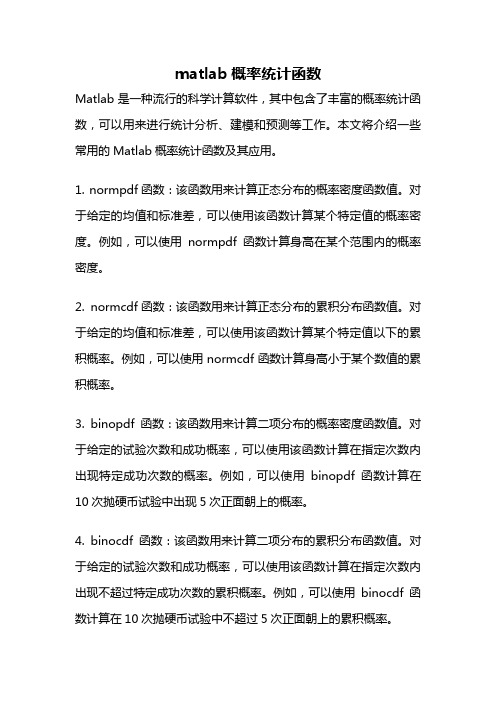
matlab概率统计函数Matlab是一种流行的科学计算软件,其中包含了丰富的概率统计函数,可以用来进行统计分析、建模和预测等工作。
本文将介绍一些常用的Matlab概率统计函数及其应用。
1. normpdf函数:该函数用来计算正态分布的概率密度函数值。
对于给定的均值和标准差,可以使用该函数计算某个特定值的概率密度。
例如,可以使用normpdf函数计算身高在某个范围内的概率密度。
2. normcdf函数:该函数用来计算正态分布的累积分布函数值。
对于给定的均值和标准差,可以使用该函数计算某个特定值以下的累积概率。
例如,可以使用normcdf函数计算身高小于某个数值的累积概率。
3. binopdf函数:该函数用来计算二项分布的概率密度函数值。
对于给定的试验次数和成功概率,可以使用该函数计算在指定次数内出现特定成功次数的概率。
例如,可以使用binopdf函数计算在10次抛硬币试验中出现5次正面朝上的概率。
4. binocdf函数:该函数用来计算二项分布的累积分布函数值。
对于给定的试验次数和成功概率,可以使用该函数计算在指定次数内出现不超过特定成功次数的累积概率。
例如,可以使用binocdf函数计算在10次抛硬币试验中不超过5次正面朝上的累积概率。
5. poisspdf函数:该函数用来计算泊松分布的概率密度函数值。
对于给定的平均发生率,可以使用该函数计算在指定时间内发生特定次数的概率。
例如,可以使用poisspdf函数计算在一小时内发生3次事故的概率。
6. poisscdf函数:该函数用来计算泊松分布的累积分布函数值。
对于给定的平均发生率,可以使用该函数计算在指定时间内发生不超过特定次数的累积概率。
例如,可以使用poisscdf函数计算在一小时内不超过3次事故的累积概率。
7. hist函数:该函数用来绘制直方图。
通过将数据分成若干个区间,该函数可以显示每个区间的频数或频率。
例如,可以使用hist函数绘制一组数据的身高分布直方图。
matlab概率统计
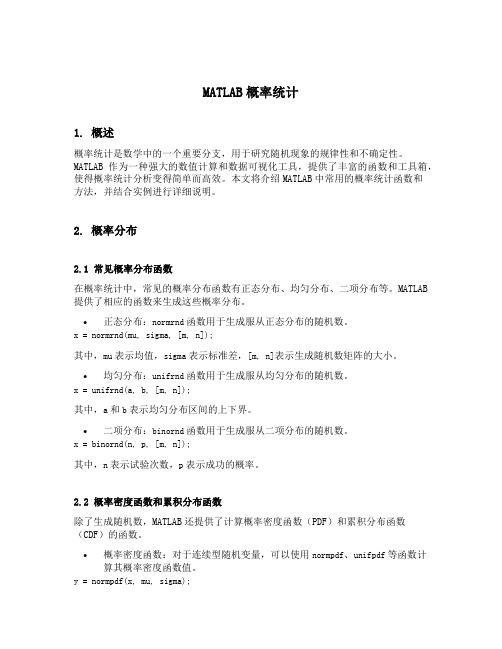
MATLAB概率统计1. 概述概率统计是数学中的一个重要分支,用于研究随机现象的规律性和不确定性。
MATLAB作为一种强大的数值计算和数据可视化工具,提供了丰富的函数和工具箱,使得概率统计分析变得简单而高效。
本文将介绍MATLAB中常用的概率统计函数和方法,并结合实例进行详细说明。
2. 概率分布2.1 常见概率分布函数在概率统计中,常见的概率分布函数有正态分布、均匀分布、二项分布等。
MATLAB 提供了相应的函数来生成这些概率分布。
•正态分布:normrnd函数用于生成服从正态分布的随机数。
x = normrnd(mu, sigma, [m, n]);其中,mu表示均值,sigma表示标准差,[m, n]表示生成随机数矩阵的大小。
•均匀分布:unifrnd函数用于生成服从均匀分布的随机数。
x = unifrnd(a, b, [m, n]);其中,a和b表示均匀分布区间的上下界。
•二项分布:binornd函数用于生成服从二项分布的随机数。
x = binornd(n, p, [m, n]);其中,n表示试验次数,p表示成功的概率。
2.2 概率密度函数和累积分布函数除了生成随机数,MATLAB还提供了计算概率密度函数(PDF)和累积分布函数(CDF)的函数。
•概率密度函数:对于连续型随机变量,可以使用normpdf、unifpdf等函数计算其概率密度函数值。
y = normpdf(x, mu, sigma);其中,x表示自变量的取值,mu和sigma表示正态分布的均值和标准差。
•累积分布函数:使用normcdf、unifcdf等函数可以计算连续型随机变量的累积分布函数值。
y = normcdf(x, mu, sigma);其中,参数的含义同上。
对于离散型随机变量,可以使用相应的离散型概率分布函数来计算其概率质量函数(PMF)和累积分布函数(CDF)。
3. 统计描述3.1 均值与方差均值和方差是统计学中常用的描述统计量,MATLAB提供了相应的函数来计算均值和方差。
Matlab在概率统计中的应用

H1 μ1≠μ2
x=[20.5 18.8 20.9 21.5 19.5 21.6 21.8]; y=[17.7 19.2 20.3 20 18.6 19 19.1 20 18.1];
corrcoef(X) ans =
1.0000 0.9563 -0.1259 -0.3706 0.2186 0.9563 1.0000 -0.0434 -0.2201 0.3524 -0.1259 -0.0434 1.0000 0.5273 0.1414 -0.3706 -0.2201 0.5273 1.0000 -0.4423 0.2186 0.3524 0.1414 -0.4423 1.0000
MATLAB中,协方差和相关系数函数cov和coffcoef实现 协方差 调用格式 cov(x)
当x是向量时,返回此向量的协方差;当x是矩阵时,返 回此矩阵的协方差矩阵,其中x的每一行是一个观测值, x的每一列是一个变量。由Cov(x)的对角元素为构成的向 量是x的各列的方差所构成的向量,diag(cov(x)是) 标准差向量
H=0 表示“在显著性水平a的情况下,不能拒绝原假设”。 H=1 表示“在显著性水平a的情况下,可以拒绝原假设”。
P为显著性概率;ci表示置信水平为1-a的置信区间。 zval是检验统计量。
例如 某糖厂用自动包装机将糖果装箱,已知规定每箱的 标准重量为100公斤。设每箱重服从正态分布。由以往经 验知重量的均方差为0.9公斤。某天开工后检验包装机是 否正常,随机抽取该包装机所包装的9箱,称得净重为 (公斤)99.3,98.7,100.5,101.2,98.3,99 .7, 105.1,102.6,100.5。取a=0.05,问机器是否正常?
8matlab概率统计

数学建模课件
主讲人:孙云龙 主讲人:
报童的诀窍2——符号运算
报纸: 进价为b ,零售价为a ,退回价为c → a>b>c 确定报童销售策略. 分析:
需求量 r 随机 购进量 n 概率 f(r) 收入 G(n) 期望值 E
模型建立: 设 购进 n 份/天 → 目标: 收入最大 需求量为 r (随机变量),分布为f(r) ,收入为G(n) 则
均值 标准差 分位点
结果: n=535
数学建模课件
主讲人:孙云龙 主讲人:
数学建模课件
主讲人:孙云龙 主讲人:
再见
SUN
�
P{X = k} =
λ
k
k!
eλ
1 f ( x) = b a 0
a ≤ x ≤b 其 它
λ eλx f (x) = 0
x >0 x≤0
X ~ N(0 1) : ,
(x) =
1 2π
e
x2 2
数学建模课件
主讲人:孙云龙 主讲人:
3,数理统计
样本 均值 参数估计 点估计 回归分析 线性 非线性 假设检验 方差分析 聚类分析 因子分析……………… 区间估计 方差
数字特征 分布特征 kurtosis(x) 峰度 k= E ( X )4
σ4
偏离情况:正态分布的峰度为3 skewness(x) 偏度
k=
E ( X )3
衡量样本均值的对称性
σ3
数学建模课件
主讲人:孙云龙 主讲人:
数字特征 相关程度 corrcoef(x) cov(x) 相关系数 协方差矩阵
1 2 N ( , σ ) : F ( x) = 2πσ
x ( y )2 2σ 2
Matlab概率统计

k=1:100;
e=1+1./k-0.996.^k;
plot(k,e)
从图上可知,最小值在10到20之间取得
21/75
列出10到20之间E(X)的值
k=10:20;
e=1+1./k-0.996.^k;
结果如下: 0.3453 0.2198 0.1393 0.1250 0.1246 0.1247 0.1270 0.2016
设某高校有n个人需要验血检查血中是否含有某种病毒若每个人单独化验需n次若把k个人的血清混合在一起化验若结果是阴性不含某种病毒只需化验一次若结果是阳性则只需对这k个人血清单独化验这k个人总共化验了k1次假设每个人含有该病毒的概率为p且这n个人是否含有该病毒是独立的设x是每个人需要化验的次数x的可能取值只有两种情况或k1k且有一个人的血清化验次数为30显然当q固定时就是要求的最理想的每组混合血清数即化验次数最少的每组的理想人数但以上式子很难求最小值点我们不妨计算出k取不同数值的化验次数就不难观察出理想的每组人数
例 3 画出正态分布 N (0,1) 和 N (0,22 ) 的概率密度函数图形.
在MATLAB中输入以下命令: x=-6:0.01:6; y=normpdf(x); z=normpdf(x,0,2); plot(x,y,x,z)
11/75
2.概率分布:P=normcdf(x,mu,sigma)
例4:某人进行射击,假设每次射击的命中率为0.02, 独立射击400次,试求至少击中两次的概率. 解:设击中的次数为X,由题意 X~b(400, 0.02) ,要求
14/75
4.均值与方差:[m,v]=normstat(mu,sigma)
例8 求正态分布N(3,52)的均值与方差. 命令为:[m,v]=normstat(3,5) 结果为:m=3,v=25
MATLAB计算概率

MATLAB计算概率在MATLAB中,计算概率可以使用MATLAB的概率和统计工具箱。
概率是一个数学领域,主要研究随机事件发生的可能性。
在计算概率时,常见的方法包括使用概率分布函数、概率密度函数和累积分布函数等。
1.概率分布函数概率分布函数(Probability Distribution Function, PDF)用于描述随机变量的取值概率分布。
MATLAB中提供了多种常见的概率分布函数,如正态分布、均匀分布、泊松分布等。
计算概率分布函数可以使用相应的函数,例如:- 正态分布:normpdf(x, mu, sigma)计算正态分布的概率密度函数值。
- 均匀分布:unifpdf(x, a, b)计算均匀分布的概率密度函数值。
- 泊松分布:poisspdf(x, lambda)计算泊松分布的概率质量函数值。
其中x为随机变量,mu、sigma、a、b和lambda是对应分布的参数。
2.概率密度函数概率密度函数(Probability Density Function, PDF)用于描述随机变量取一些特定值的概率密度。
计算概率密度函数可以使用相应的函数,例如:- 正态分布:normpdf(x, mu, sigma)计算正态分布的概率密度函数值。
- 均匀分布:unifpdf(x, a, b)计算均匀分布的概率密度函数值。
- 泊松分布:poisspdf(x, lambda)计算泊松分布的概率质量函数值。
其中x为随机变量,mu、sigma、a、b和lambda是对应分布的参数。
3.累积分布函数累积分布函数(Cumulative Distribution Function, CDF)用于描述随机变量取值小于或等于一些特定值的概率。
计算累积分布函数可以使用相应的函数,例如:- 正态分布:normcdf(x, mu, sigma)计算正态分布的累积分布函数值。
- 均匀分布:unifcdf(x, a, b)计算均匀分布的累积分布函数值。
概率统计在MATLAB中的实现方法解析

概率统计在MATLAB中的实现方法解析概率统计是一门研究随机现象的规律性和不确定性的学科,广泛应用于各个领域。
而MATLAB是一种强大的科学计算软件,可以在概率统计领域中提供很多实用的工具和方法。
本文将探讨概率统计在MATLAB中的实现方法,帮助读者更好地理解和应用于实践。
一、概率分布的生成和拟合在概率统计中,对于一些已知的概率分布,我们常常需要生成符合该分布的随机数,或者通过已有的样本数据对分布进行拟合。
在MATLAB中,可以使用一些函数来实现这些操作。
首先,对于已知的概率分布,例如正态分布(高斯分布),可以使用normrnd()函数生成符合该分布的随机数。
该函数的输入参数包括均值和标准差,输出为符合正态分布的随机数。
例如,我们可以生成100个符合均值为0,标准差为1的正态分布随机数:```MATLABx = normrnd(0, 1, 100, 1);```对于已有的样本数据,我们可以使用fitdist()函数对数据进行概率分布的拟合。
该函数可以自动选择合适的分布类型,并给出对应的参数估计值。
例如,我们有一组样本数据x,需要对其进行正态分布的拟合:```MATLABdist = fitdist(x, 'Normal');```通过fitdist()函数返回的dist对象,我们可以获取该分布的参数估计值、置信区间等信息。
二、假设检验和置信区间估计假设检验和置信区间估计是概率统计中常用的分析方法,用于判断样本数据是否符合某个假设、计算参数估计的可信度等。
在MATLAB中,可以使用一些函数来实现假设检验和置信区间估计。
对于假设检验,MATLAB提供了ttest2()和chi2gof()等函数,用于分别进行两样本t检验和卡方检验。
例如,我们有两组样本数据x和y,需要进行两样本t检验:```MATLAB[h, p] = ttest2(x, y);```通过ttest2()函数返回的h值可以判断是否拒绝原假设,p值则表示检验结果的显著性。
使用Matlab进行概率统计分析的方法
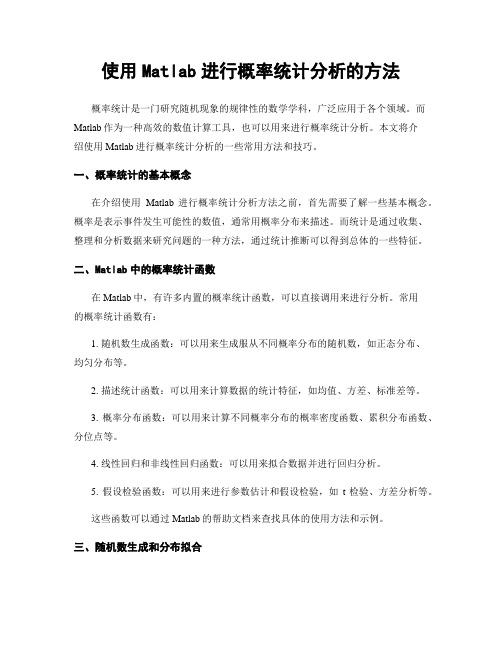
使用Matlab进行概率统计分析的方法概率统计是一门研究随机现象的规律性的数学学科,广泛应用于各个领域。
而Matlab作为一种高效的数值计算工具,也可以用来进行概率统计分析。
本文将介绍使用Matlab进行概率统计分析的一些常用方法和技巧。
一、概率统计的基本概念在介绍使用Matlab进行概率统计分析方法之前,首先需要了解一些基本概念。
概率是表示事件发生可能性的数值,通常用概率分布来描述。
而统计是通过收集、整理和分析数据来研究问题的一种方法,通过统计推断可以得到总体的一些特征。
二、Matlab中的概率统计函数在Matlab中,有许多内置的概率统计函数,可以直接调用来进行分析。
常用的概率统计函数有:1. 随机数生成函数:可以用来生成服从不同概率分布的随机数,如正态分布、均匀分布等。
2. 描述统计函数:可以用来计算数据的统计特征,如均值、方差、标准差等。
3. 概率分布函数:可以用来计算不同概率分布的概率密度函数、累积分布函数、分位点等。
4. 线性回归和非线性回归函数:可以用来拟合数据并进行回归分析。
5. 假设检验函数:可以用来进行参数估计和假设检验,如t检验、方差分析等。
这些函数可以通过Matlab的帮助文档来查找具体的使用方法和示例。
三、随机数生成和分布拟合随机数生成是概率统计分析的基础,Matlab提供了多种随机数生成函数。
例如,可以使用rand函数生成服从均匀分布的随机数,使用randn函数生成服从标准正态分布的随机数。
通过设置不同的参数,可以生成不同分布的随机数。
分布拟合是将实际数据与理论概率分布进行对比的方法,可以帮助我们判断数据是否符合某种分布。
Matlab提供了fitdist函数用于对数据进行分布拟合,可以根据数据自动选择合适的概率分布进行拟合,并返回相应的参数估计结果。
通过对数据拟合后的分布进行分析,可以更好地了解数据的性质。
四、描述统计和数据可视化描述统计是在数据收集和整理之后,对数据进行总结和分析的过程。
完整版Matlab概率论及数理统计
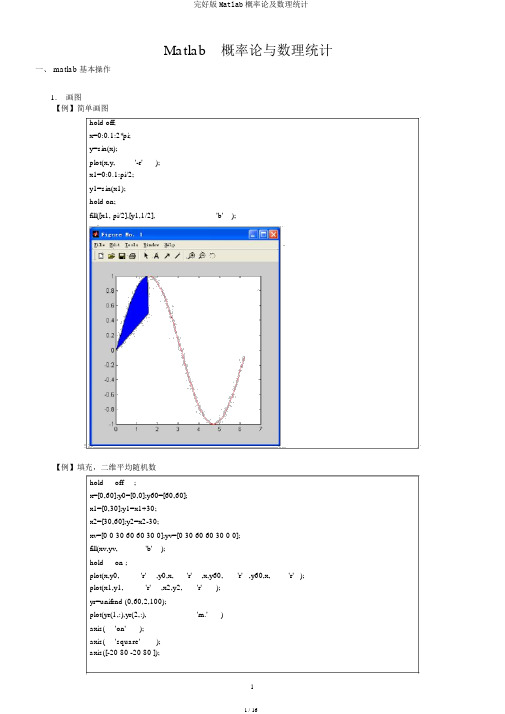
Matlab概率论与数理统计一、 matlab 基本操作1.画图【例】简单画图hold off;x=0:0.1:2*pi;y=sin(x);plot(x,y,'-r');x1=0:0.1:pi/2;y1=sin(x1);hold on;fill([x1, pi/2],[y1,1/2],'b' );【例】填充,二维平均随机数hold off;x=[0,60];y0=[0,0];y60=[60,60];x1=[0,30];y1=x1+30;x2=[30,60];y2=x2-30;xv=[0 0 30 60 60 30 0];yv=[0 30 60 60 30 0 0];fill(xv,yv,'b');hold on ;plot(x,y0,'r',y0,x,'r',x,y60,'r' ,y60,x,'r' );plot(x1,y1,'r',x2,y2,'r');yr=unifrnd (0,60,2,100);plot(yr(1,:),yr(2,:),'m.')axis('on');axis('square');2.排列组合C=nchoosek(n,k) :C C n k,例 nchoosek(5,2)=10, nchoosek(6,3)=20.prod(n1:n2) :从 n1 到 n2 的连乘【例】最少有两个人寿辰相同的概率n!C N nN !( N n)!N(N1)(N n1)公式计算 p 111N nN n N n365 364 (365rs1)365364365rs 1 1365rs1365365365rs=[20,25,30,35,40,45,50];%每班的人数p1=ones(1,length(rs));p2=ones(1,length(rs));%用连乘公式计算for i=1:length(rs)p1(i)=prod(365-rs(i)+1:365)/365^rs(i);end%用公式计算(改进)for i=1:length(rs)for k=365-rs(i)+1:365p2(i)=p2(i)*(k/365);end ;endp1(i)=exp(sum(log(365-rs(i)+1:365))-rs(i)*log(365));endp_r1=1-p1;p_r2=1-p2;Rs =[20253035404550 ]P_r=[0.4114 0.5687 0.7063 0.8144 0.8912 0.9410 0.9704]二、随机数的生成3.平均分布随机数rand(m,n); 产生 m 行 n 列的 (0,1) 平均分布的随机数rand(n); 产生 n 行 n 列的 (0,1)平均分布的随机数【练习】生成(a,b)上的平均分布4.正态分布随机数randn(m,n); 产生 m 行 n 列的标准正态分布的随机数【练习】生成N(nu,sigma.^2) 上的正态分布5.其他分布随机数函数名调用形式注释Unidrnd unid rnd (N,m,n)平均分布(失散)随机数binornd bino rnd (N,P,m,n)参数为 N, p的二项分布随机数Poissrnd poiss rnd (Lambda,m,n)参数为 Lambda的泊松分布随机数geornd geornd (P,m,n)参数为 p 的几何分布随机数hygernd hygernd (M,K,N,m,n)参数为 M, K, N 的超几何分布随机数Normrnd normrnd (MU,SIGMA,m,n)参数为 MU, SIGMA的正态分布随机数,SIGMA是标准差Unifrnd unif rnd ( A,B,m,n)[A,B] 上平均分布 ( 连续 ) 随机数Exprnd exprnd (MU,m,n)参数为 MU的指数分布随机数chi2rnd chi2 rnd(N,m,n)自由度为 N 的卡方分布随机数Trnd t rnd(N,m,n)自由度为 N 的 t分布随机数Frnd f rnd(N1, N2,m,n)第一自由度为N1, 第二自由度为 N2 的 F 分布随机数gamrnd gamrnd(A, B,m,n)参数为 A, B的分布随机数betarnd betarnd(A, B,m,n)参数为 A, B的分布随机数lognrnd lognrnd(MU, SIGMA,m,n)参数为 MU, SIGMA的对数正态分布随机数nbinrnd nbinrnd(R, P,m,n)参数为 R,P 的负二项式分布随机数ncfrnd ncfrnd(N1, N2, delta,m,n)参数为 N1, N2, delta 的非中心 F 分布随机数nctrnd nctrnd(N, delta,m,n)参数为 N,delta的非中心 t 分布随机数ncx2rnd ncx2rnd(N, delta,m,n)参数为 N,delta的非中心卡方分布随机数raylrnd raylrnd(B,m,n)参数为 B 的瑞利分布随机数weibrnd weibrnd(A, B,m,n)参数为 A, B的韦伯分布随机数三、一维随机变量的概率分布1.失散型随机变量的分布率(1)0-1 分布(2)平均分布(3) 二项分布: binopdf(x,n,p) ,若X ~ B(n, p),则P{ X k} C n k p k (1p) n k,x=0:9;n=9;p=0.3;y= binopdf(x,n,p);plot(x,y,'b-',x,y,'r*')y=[ 0.0404, 0.1556, 0.2668, 0.2668, 0.1715, 0.0735, 0.0210, 0.0039, 0.0004, 0.0000 ]‘当 n 较大时二项分布近似为正态分布x=0:100;n=100;p=0.3;y= binopdf(x,n,p);plot(x,y,'b-',x,y,'r*')(4) 泊松分布: piosspdf(x, lambda) ,若X ~k e ( ) ,则 P{ X k}k !x=0:9; lambda = 3;y= poisspdf (x,lambda);plot(x,y,'b-',x,y,'r*')y=[ 0.0498, 0.1494, 0.2240, 0.2240, 0.1680, 0.1008, 0.0504, 0.0216, 0.0081, 0.0027 ](5) 几何分布: geopdf (x, p),则P{ X k} p(1p) k 1y= geopdf(x,p);plot(x,y,'b-',x,y,'r*')y=[ 0.3000, 0.2100, 0.1470, 0.1029, 0.0720, 0.0504, 0.0353, 0.0247, 0.0173, 0.0121 ]C M k C N n k Mx=0:10;N=20;M=8;n=4;y= hygepdf(x,N,M,n);plot(x,y,'b-',x,y,'r*')y=[ 0.1022, 0.3633, 0.3814, 0.1387, 0.0144, 0, 0, 0, 0, 0, 0 ]2.概率密度函数1a x b(1)平均分布: unifpdf(x,a,b) ,f ( x)b a0其他a=0;b=1;x=a:0.1:b;y= unifpdf (x,a,b);112(2)正态分布: normpdf(x,mu,sigma) ,f ( x)e2 2 ( x)2x=-10:0.1:12;mu=1;sigma=4;y= normpdf(x,mu,sigma);rn=10000;z= normrnd (mu,sigma,1,rn); %产生 10000 个正态分布的随机数d=0.5;a=-10:d:12;b=(hist(z,a)/rn)/d;% 以 a 为横轴,求出 10000 个正态分布的随机数的频率plot(x,y,'b-',a,b,'r.')(3) 指数分布: exppdf(x,mu) ,f (x)1 e1xa x by= exppdf(x,mu); plot(x,y,'b-',x,y,'r*')1n1(4)2分布: chi2pdf(x,n) , f (x; n)2n 2x2( n 2)hold on x=0:0.1:30;n=4;y= chi2pdf(x,n);plot(x,y,'b');%blue n=6;y= chi2pdf(x,n);plot(x,y,'r');%redn=8;y= chi2pdf(x,n);plot(x,y,'c');%cyan n=10;y= chi2pdf(x,n);plot(x,y,'k');%black legend('n=4', 'n=6', 'n=8', 'n=10');(( n 1) 2) x 2(5) t 分布: tpdf(x,n) , f (x; n)(n 2)1nnhold on x=-10:0.1:10;n=2;y= tpdf(x,n);plot(x,y,'b');%blue e 2n 1 2x 0x 0n=20;y= tpdf(x,n);plot(x,y,'k');%black legend('n=2', 'n=6', 'n=10', 'n=20');n1n1 2n1n222(6) F 分布: fpdf(x,n1,n2) ,f ( x; n1, n2)(( n1n2 ) 2) n1x 21n1x x 0 (n1 2)(n2 2) n2n20x 0hold onx=0:0.1:10;n1=2; n2=6;y= fpdf(x,n1,n2);plot(x,y,'b');%bluen1=6; n2=10;y= fpdf(x,n1,n2);plot(x,y,'r');%redn1=10; n2=6;y= fpdf(x,n1,n2);plot(x,y,'c');%cyann1=10; n2=10;y= fpdf(x,n1,n2);plot(x,y,'k');%blacklegend(' n1=2; n2=6', ' n1=6; n2=10', ' n1=10; n2=6', ' n1=10; n2=10');3.分布函数 F (x) P{ X x}【例】求正态分布的累积概率值设 X ~ N(3,22),求P{2X 5},P{ 4 X 10},P{ X 2}, P{X3} ,4.逆分布函数,临界值y F (x) P{ X x} , x F 1 ( y) , x 称之为临界值【例】求标准正态分布的累积概率值y=0:0.01:1;x=norminv(y,0,1);【例】求2 (9) 分布的累积概率值hold offy=[0.025,0.975];x=chi2inv(y,9);n=9;x0=0:0.1:30;y0=chi2pdf(x0,n);plot(x0,y0,'r');x1=0:0.1:x(1);y1=chi2pdf(x1,n);x2=x(2):0.1:30;y2=chi2pdf(x2,n);hold onfill([x1, x(1)],[y1,0],'b');fill([x(2),x2],[0,y2],'b');5. 数字特色函数名调用形式注释sort sort(x),sort(A)排序 ,x 是向量, A 是矩阵,按各列排序sortrows sortrows(A) A 是矩阵,按各行排序mean mean(x)向量 x 的样本均值var var(x)向量 x 的样本方差std std(x)向量 x 的样本标准差median median(x)向量 x 的样本中位数geomean geomean(x)向量 x 的样本几何平均值harmmean harmmean(x)向量 x 的样本调停平均值skewness skewness(x)向量 x 的样本偏度max max(x)向量 x 的最大值min min(x)向量 x 的最小值cov cov(x), cov(x,y)向量 x 的方差,向量x,y 的协方差矩阵corrcoef corrcoef(x,y)向量 x,y 的相关系数矩阵【练习】二项分布、泊松分布、正态分布( 1)对n10, p 0.2 二项分布,画出 b(n, p) 的分布律点和折线;( 2)对np ,画出泊松分布( ) 的分布律点和折线;( 3)对np,2np(1 p) ,画出正态分布N ( , 2 )的密度函数曲线;( 4)调整 n, p ,观察折线与曲线的变化趋势。
- 1、下载文档前请自行甄别文档内容的完整性,平台不提供额外的编辑、内容补充、找答案等附加服务。
- 2、"仅部分预览"的文档,不可在线预览部分如存在完整性等问题,可反馈申请退款(可完整预览的文档不适用该条件!)。
- 3、如文档侵犯您的权益,请联系客服反馈,我们会尽快为您处理(人工客服工作时间:9:00-18:30)。
8.1.2.7 F 分布
其为参数p,q的函数,且p,q均为正整数。
• 例:分别绘制(p,q)为(1,1),(2,1),(3,1)(3,2),(4,1)时F 分布的概率密度函数与分布函数曲线。
>> x=[-eps:-0.02:-0.5,0:0.02:1]; x=sort(x'); >> p1=[1 2 3 3 4]; q1=[1 1 1 2 1]; y1=[]; y2=[]; >> for i=1:length(p1) y1=[y1,fpdf(x,p1(i),q1(i))]; y2=[y2,fcdf(x,p1(i),q1(i))]; end >> plot(x,y1), figure; plot(x,y2)
Distribution Beta Distribution Binomial Distribution
Chi-Square Distribution Exponential Distribution Extreme Value Distribution Gamma Distribution Generalized Extreme Value
8.1.2.6 Rayleigh分布
• 例:
>> x=[-eps:-0.02:-0.5,0:0.02:5]; x=sort(x'); >> b1=[.5,1,3,5]; y1=[]; y2=[]; >> for i=1:length(b1) y1=[y1,raylpdf(x,b1(i))]; y2=[y2,raylcdf(x,b1(i))]; end >> plot(x,y1), figure; plot(x,y2)
8.1.2.4
分布(卡方分布)
其为一特殊的
分布 ,a=k/2, l =1/2。
• 例:
>> x=[-eps:-0.02:-0.5,0:0.02:2]; x=sort(x'); >> k1=[1,2,3,4,5]; y1=[]; y2=[]; >> for i=1:length(k1) y1=[y1,chi2pdf(x,k1(i))]; y2=[y2,chi2cdf(x,k1(i))];end >> plot(x,y1), figure; plot(x,y2)
name 'beta' or 'Beta' 'bino' or 'Binomial'
'chi2' or 'Chisquare' 'exp' or 'Exponential' 'ev' or 'Extreme Value' 'gam' or 'Gamma' 'gev' or 'Generalized 'gp' or 'Generalized Pareto' 'geo' or 'Geometric' 'hyge' or 'Hypergeometric'
Uniform Distribution (Discrete) N: maximum observable Weibull Distribution a: scale parameter
• 例: 计算正态分布N(0,1)的随机变量X在点 0.6578的密度函数值。 • 解: >> pdf('norm',0.6578,0,1) • ans = • 0.3213
8.1.2.5
概率密度函数为:
分布
其为参数k的函数,且k为正整数。
• 例:
>> x=[-5:0.02:5]'; k1=[1,2,5,10]; y1=[]; y2=[]; >> for i=1:length(k1) y1=[y1,tpdf(x,k1(i))]; y2=[y2,tcdf(x,k1(i))]; end >> plot(x,y1), figure; plot(x,y2)
ν1: numerator degrees
ν: degrees of freedom ν: degrees of freedom μ: mean λ: mean b: scale parameter ν: degrees of freedom a: lower endpoint
ν2: denominator degrees
8.1.2.2 正态分布
正态分布的概率密度函数为:
• 例:
>> x=[-5:.02:5]'; y1=[]; y2=[]; >> mu1=[-1,0,0,0,1]; sig1=[1,0.1,1,10,1]; sig1=sqrt(sig1); >> for i=1:length(mu1) y1=[y1,normpdf(x,mu1(i),sig1(i))]; y2=[y2,normcdf(x,mu1(i),sig1(i))]; end >> plot(x,y1), figure; plot(x,y2)
例: 求标准正态分布随机变量X落在区间(-∞, 0.4)内的概率。 解:>> cdf('norm',0.4,0,1) ans = 0.6554
例:求自由度为16的卡方分布随机变量落在[0, 6.91]内的概率。 解:>> cdf('chi2',6.91,16) ans = 0.0250
随机变量的逆累积分布函数 MATLAB中的逆累积分布函数是已知,求x。 命令 icdf 计算逆累积分布函数 格式 icdf(‘name’,K,A) icdf(‘name’,K,A,B) icdf(‘name’,K,A,B,C) 说明 返回分布为name,参数为a1,a2,a3,累 积概率值为P的临界值,这里name与前面相同。 如果F= cdf(‘name’,X,A,B,C) , 则 X = icdf(‘name’,F,A,B,C)
• 例:自由度为8的卡方分布,在点2.18处的密度函数 值。 • 解: >> pdf('chi2',2.18,8) • ans = • 0.0363
随机变量的累积概率值(分布函数值) 通用函数cdf用来计算随机变量的概率之和 (累积概率值) 函数 cdf 格式 cdf(‘name’,K,A) cdf(‘name’,K,A,B) cdf(‘name’,K,A,B,C) 说明 返回以name为分布、随机变量X≤K的概率 之和的累积概率值,name为分布函数名.
— — — — μ: location parameteห้องสมุดไป่ตู้ μ: threshold (location) — n: number of samples — —
Generalized Pareto Distribution k: tail index (shape) Geometric Distribution Hypergeometric Distribution p: probability parameter M: size of the population
8.1.2 常见分布的概率密度函数与分布函数
8.1.2.1 Poisson分布
其要求x是正整数。
其中:x为选定的一组横坐标向量, y为x各点处的概率密度函数值。
• 例:绘制 l =1,2,5,10 时 Poisson 分布的概率密 度函数与概率分布函数曲线。
>> x=[0:15]'; y1=[]; y2=[]; lam1=[1,2,5,10]; >> for i=1:length(lam1) y1=[y1,poisspdf(x,lam1(i))]; y2=[y2,poisscdf(x,lam1(i))]; end >> plot(x,y1), figure; plot(x,y2)
8.1.3 概率问题的求解
图4-9
• 例:
>> b=1; p1=raylcdf(0.2,b); p2=raylcdf(2,b); P1=p2-p1 P1 = 0.8449
>> p1=raylcdf(1,b); P2=1-p1 P2 = 0.6065
'nct' or 'Noncentral t' 'ncx2' 'norm' or 'Normal' 'poiss' or 'Poisson' 'rayl' or 'Rayleigh' 't' or 'T' 'unif' or 'Uniform' 'unid' or 'Discrete Uniform' 'wbl' or 'Weibull'
'logn' or 'Lognormal' Lognormal Distribution μ 'nbin' or 'Negative Binomial' Negative Binomial Distribution r: number of successes
'ncf' or 'Noncentral F'
Noncentral F Distribution
Noncentral t Distribution Noncentral Chi-Square Normal Distribution Poisson Distribution Rayleigh Distribution Student's t Distribution Uniform Distribution
